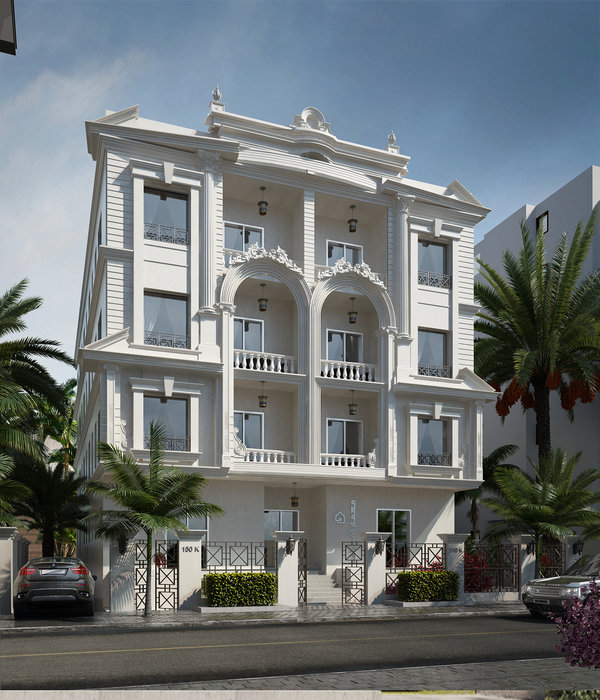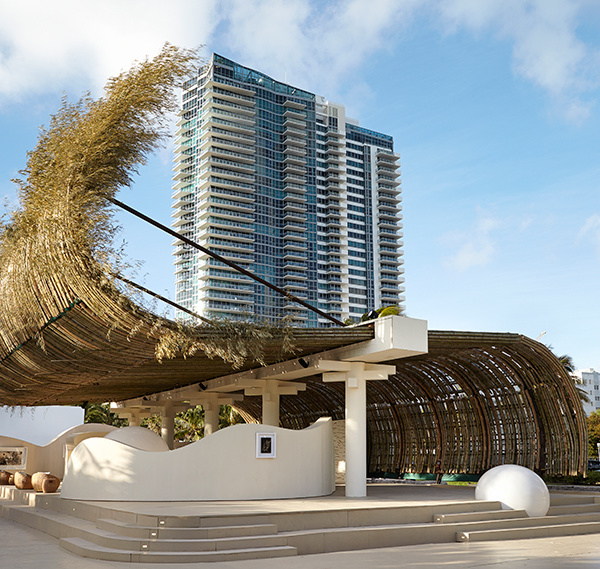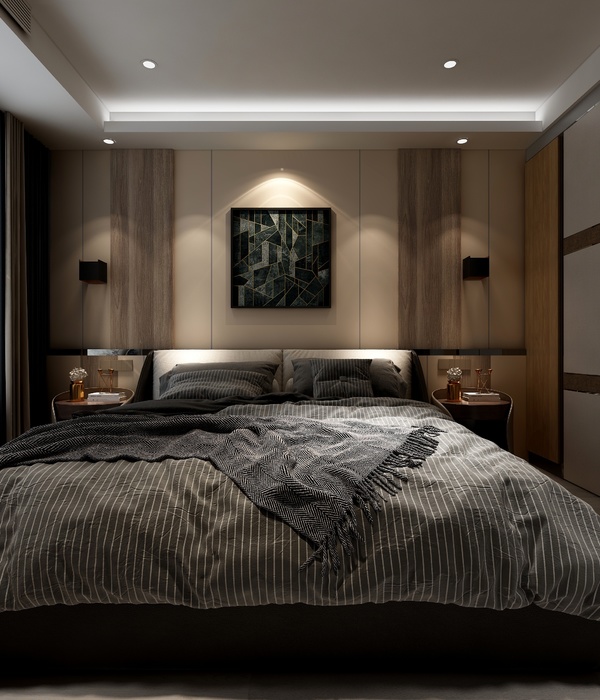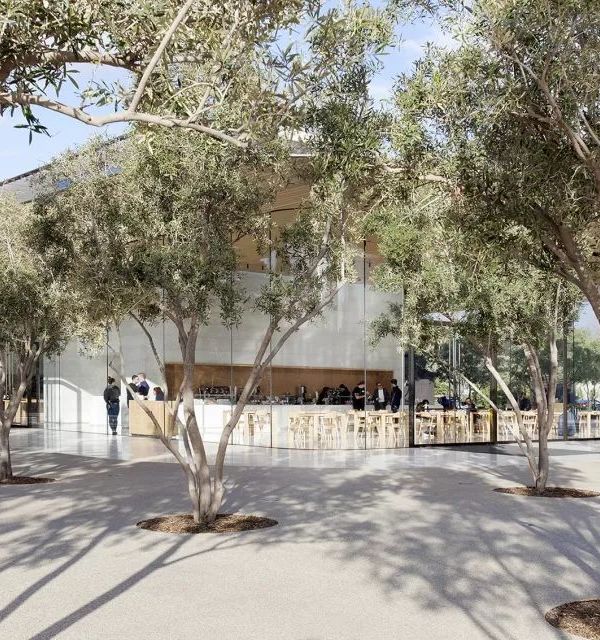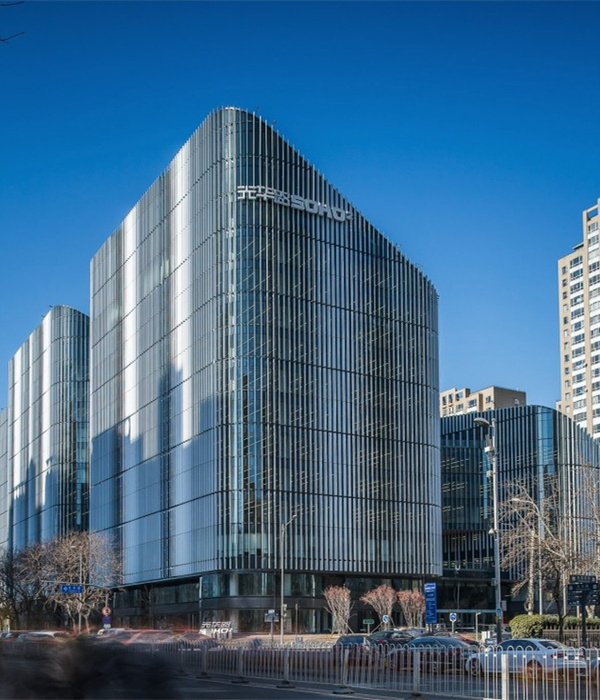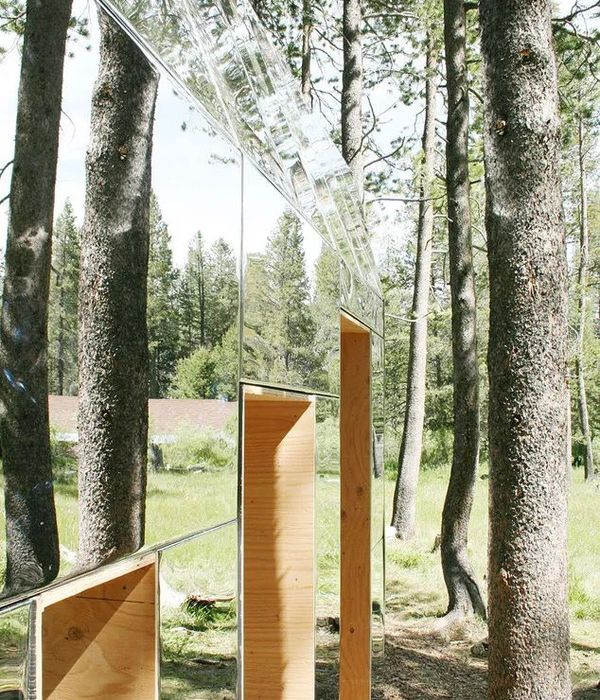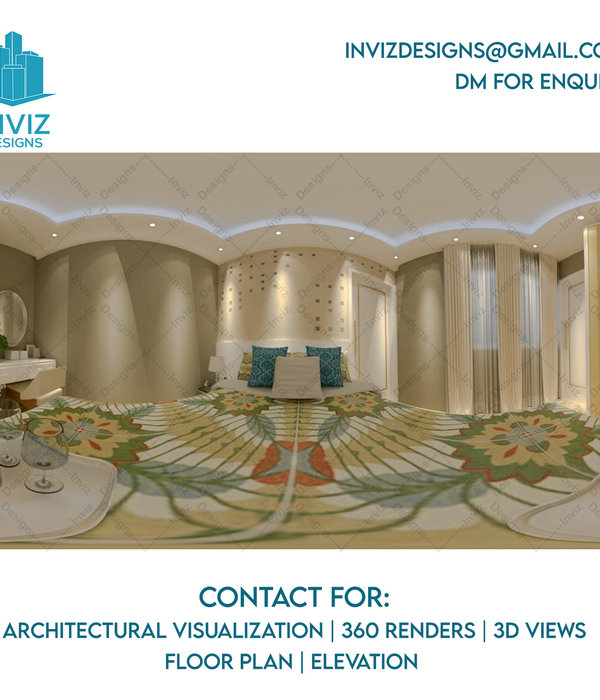阿布扎比火烈鸟游客中心 | 有机设计融入自然
petrjanda/brainwork:该项目的主要设计目标是在各个层面将游客中心与保护区和自然连接起来,创造出具有独特空间感的自主环境。利用特殊的材料模仿自然形状,将建筑外观与保护区自然环境有机地联系起来。最后形成的建筑看起来既古老又现代,甚至还有几分未来感。
petrjanda/brainwork: The main idea is to connect the visitor centre with the reserve’s nature at all levels of the project. To create an autonomous environment with the distinct genius loci. Using material and shape mimicry, the building organically connects its appearance with the environment of the reserve. It looks very old and, at the same time, contemporary or even futuristic.

设计利用了自然有机和无机成分之间的自然联系,渗透到建筑的技术部分 (冷却和冷凝系统),以及所有的展示和教学策略 (立面部分、水元素和室内生物)。再将各个独立的活动空间流畅地连接成相互交织的连续平面,创造出了大量令人赞叹的空间,在这样一个小区域内实现了复杂的印象和信息的自发传递。而且这个酷似火烈鸟巢的游客中心建筑,同时也是一个小型的博物馆,可用于展览和项目扩展 (受类胡萝卜素影响的活体形式的细节,形成小生物群落的部分活体展示)。
It works with the natural connection between the organic and inorganic components of nature, which permeates not only the technical part of the building (cooling and condensation system) but also all exhibition and didactic strategies (living parts of the facades, water elements and indoor life organisms). The smooth connection of individual operation sections into an intertwined continuous floor plan creates a large number of surprising situations achieving a complex impression and spontaneous transfer of information to visitors on a small area. The building is designed as a visitor centre containing elements of a small museum with emphasis on flamingo nesting, allowing exhibition and program expansion (specifics of live forms influenced by carotenoid, partially live displays forming small biotopes).
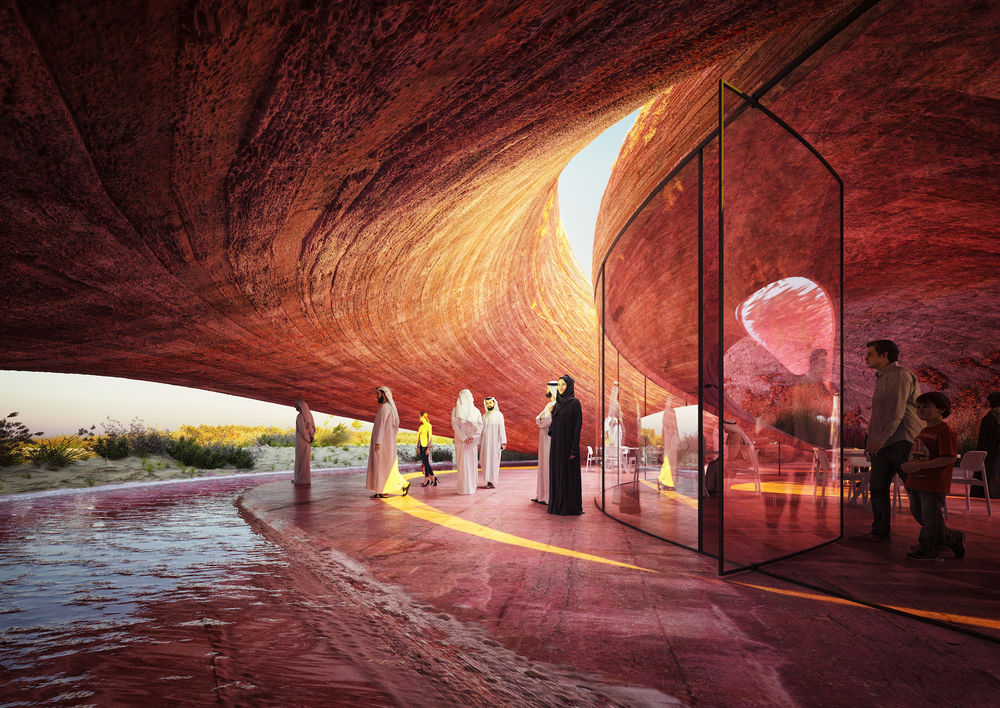
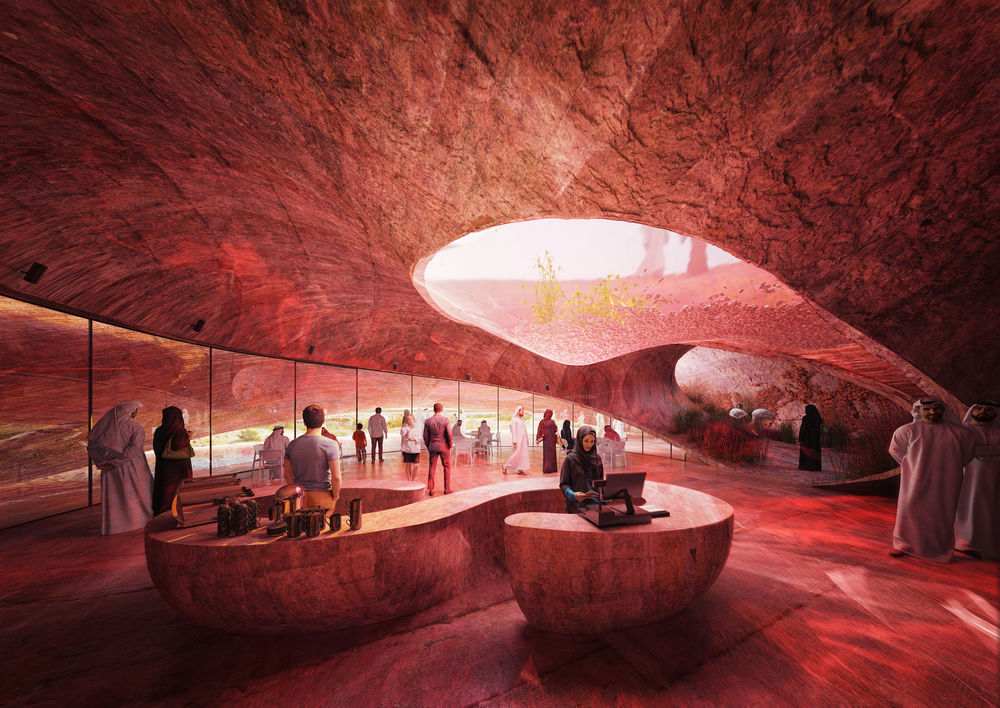

建筑设计、空间布局 Architectural design, spatial configuration
建筑的整体空间布局呈一个O形和S形交织的圆状平面,自然地引导游客穿过褶皱,依次来到建筑项目的特色节点,以及与保护区的互动空间。该建筑没有采用二维平面图的原因在于,它更多的是对三维世界自然优雅的颂扬。动态的曲线布局和连续的造型方便了人们建筑周围的自由行走观景,从而帮助调节游客的无限多样感知。这种没有任何结构连接的界面空间,使得室内外融合成了光影庭院,赋予了建筑的永恒性。
虽然建筑的特殊形状,似乎快要与地形融为一体,但其鲜明的特色,会更容易激发远处游客的探索兴趣。该建筑利用人类从小就习惯观察自然现象的暗示(比如云中的图像)激发了观察者的想象力。建筑通过形状、材料和零碎的指示间接和潜意识地表达其内涵,而由此产生的形态并不只是代表某一种明确的地貌或动物形态,你可以把它看作是一只熟睡的火烈鸟的形态,也可以把它看做是经过侵蚀形成的阿拉伯沙漠岩层。但设计确实强调了鸟瞰与火烈鸟和他们的迁移和飞行相关的主题。该建筑参照了少数几个对象,从空中观看也是观察它们的一部分(我们在设计过程中,咨询了鸟类学家和鸟类摄影师对鸟类行为和鸟类对建筑外观和环境变化可能产生的反应,这种有机形状的地标建筑更有利于他们的飞翔定位)。
The spatial arrangement of the building is based on an O and S-shape intertwined composition with a circular floor plan, which naturally leads visitors through its folds and gradually opens the individual highlights of the building’s program and its interaction with the reserve. The building deliberately does not work with two-dimensional floor plans. In fact, it is more of a celebration of a three-dimensional natural world and its natural elegance. The dynamic curve arrangement and continuous shaping enables barrier-free movement around the building and infinitely diverse modulation of visitors’ perception. Blending of exterior into a shaded forecourt and interior almost without a structurally articulated interface gives the object its timelessness.
View from a distance while arriving at the building initiates visitors into exploring the object, which, despite its iconic character, seems to merge with the terrain. The building works with the observer’s imagination using hints of natural phenomena that we have been used to reading since childhood (such as images in the clouds). The building thus refers to its connotations indirectly and subliminally through shape, material and fragmentary indications. The resulting form is thus not unequivocally geomorphic or zoomorphic, it can be seen as references to the morphology of a sleeping flamingo as well as to rock formations in the Arabian desert with their significant stratification revealed by erosion. The design uses emphasis on bird’s eye view with regard to the topic associated with flamingos and their migration and flying. The building belongs to a few objects where the view from the air is part of their reading (during the design process we consulted ornithologists and bird photographers on birds behaviour and possible reaction of birds to the appearance of the building and environmental change, and a landmark with organic shape seems to be beneficial for their orientation).
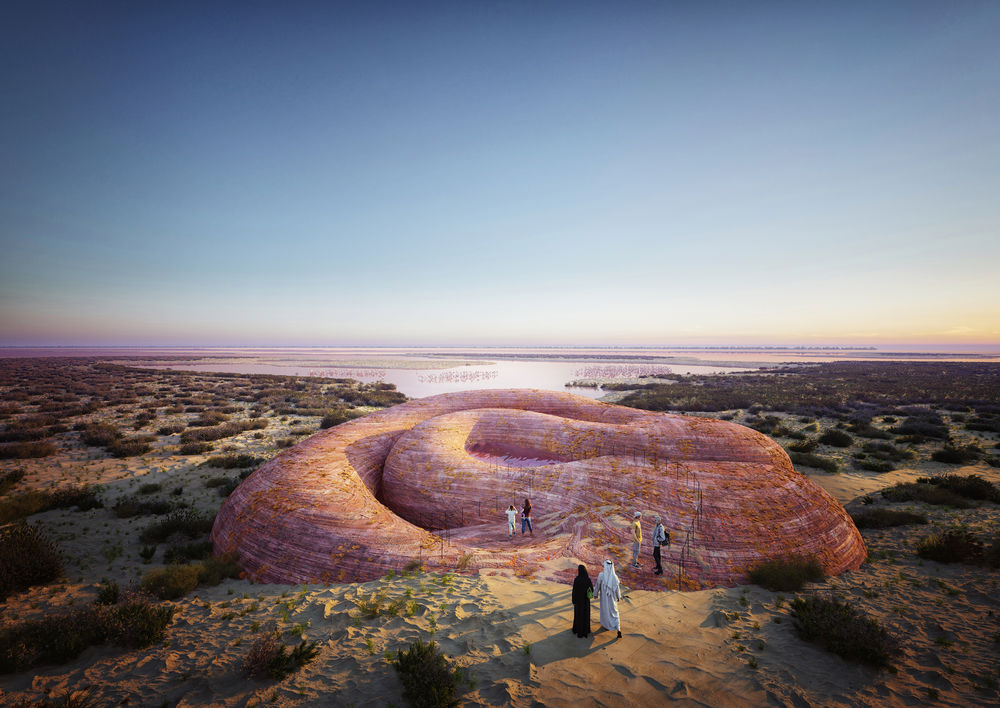

流线组织 Dramaturgy and program content
游客的流线设计以建筑及其内容的逐步探索和展示 (类似于整个保护区的探索) 为基础。建筑内部没有被划分各个独立的空间,游客可以通过几个相互连接的区域自由移动,这些区域包含了所有必需的功能空间、技术和组织空间,以及几个游客无法进入的补充型空间。
从停车场进入中心,穿过屋顶,屋顶上的湖 (粉色湖泊生物区) 的透明底部可帮助采光照亮下面大楼的主厅。而游客们可通过这里的渐变坡道,穿过建筑旋转管道之间的褶皱来到一个被悬挑遮挡的观察平台,这里设有整个展示区和保护区的主要观察点。阶地与保护区之间隔着一个海湾,海湾由水与含有保护区特有微生物的盐水生物区组成。我们的设计基于展览内容比较复杂,且拥有特定的保护区环境,所以以较大的画面勾勒描绘出设计方法,展示受类胡萝卜素 (火烈鸟、水、甲壳类动物、植物、藻类) 和其他可能主题所影响颜色变化的原理。该展览将融入部分植物和水族馆形式,这样会有助于保持不同湿度和场地的宜人气候。游客在到达展览馆的最高点后,可通过一个宽阔的全景窗口观看到保护区的最大视野。与此同时,我们另一个用于分隔游客活动的原则是在游客中心划分适当的遮蔽区 (室内和遮阳露台) 和露天储备使用区和停车区。
The strategy of the visitor’s movement is based on the gradual exploring and revealing of the building and its contents (similarly to the entire reserve exploration). The building is not divided into individual rooms and visitors move through several interconnected sectors that contain all the required functions, and are supplemented by technical and organizational spaces and complements inaccessible to visitors.
From the car park, access to the building leads through the roof, on which there is a lake (pink lake biotope) illuminating through the transparent bottom the main hall of the building below. Using a gradual ramp, visitors descend through a fold between the rotating tubes of the building’s volume to an observation terrace shaded from the sun by a levitating overhang – a tube containing the display area and the main viewpoint of the reserve. The terrace is separated from the reserve by a bay formed by a water element with a saltwater biotope containing microorganisms specific to the reserve.
Our proposal sees the exhibition content as more complex and uses the specific reserve environment to outline the methodology in a bigger picture, showing the principles of colour changes affected by carotenoid (flamingos, water, crustacean, plants, algae) and other possible topics. The exhibition is conceived as partially live with the plants and aquariums that help to maintain a pleasant climate with different humidity. Proceeding in the exhibition, visitors get to the culminating height point of the exhibition tube, which allows a maximum view of the reserve through a wide panoramic window.
Another principle used to separate movement of visitors is a division into a sheltered area of the visitor centre (interior and shaded terraces) and movement around the reserve and Parking area in the open air.
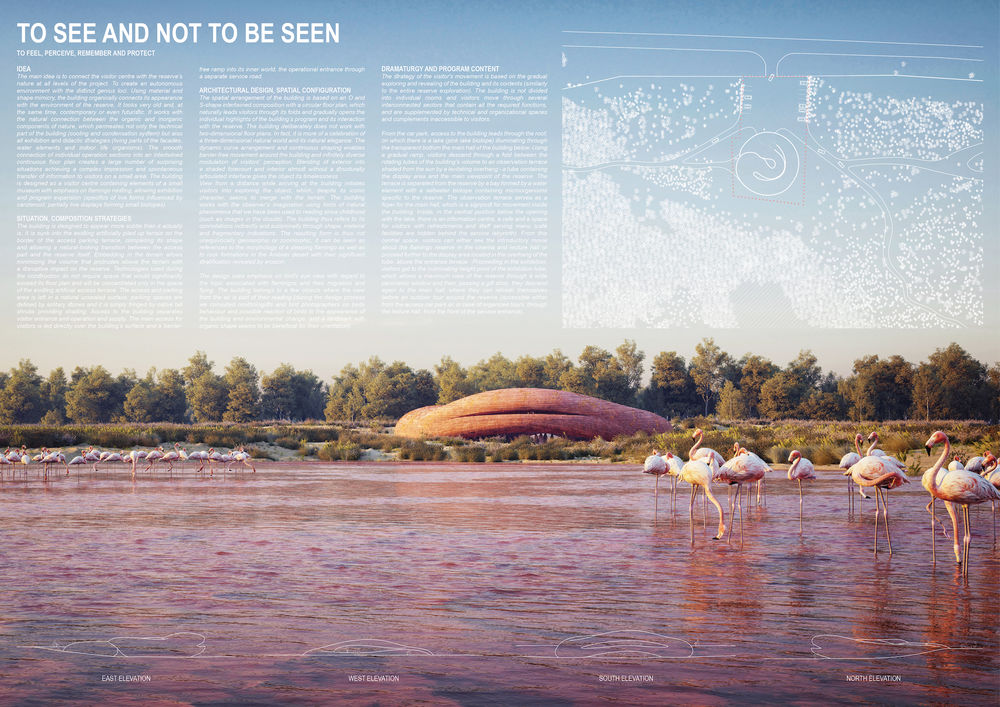
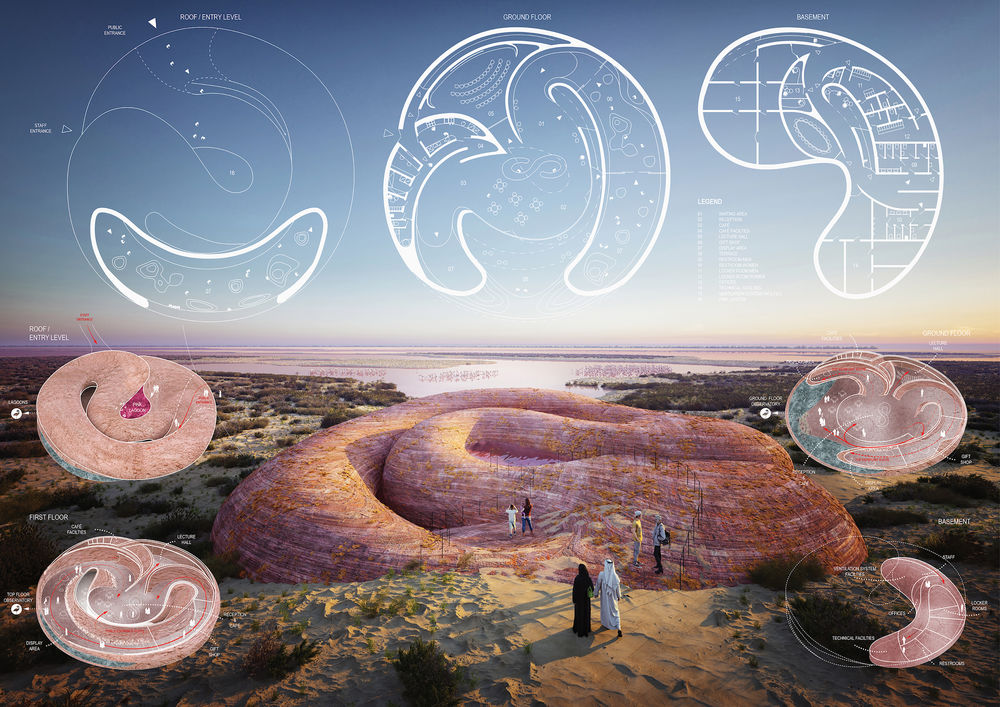
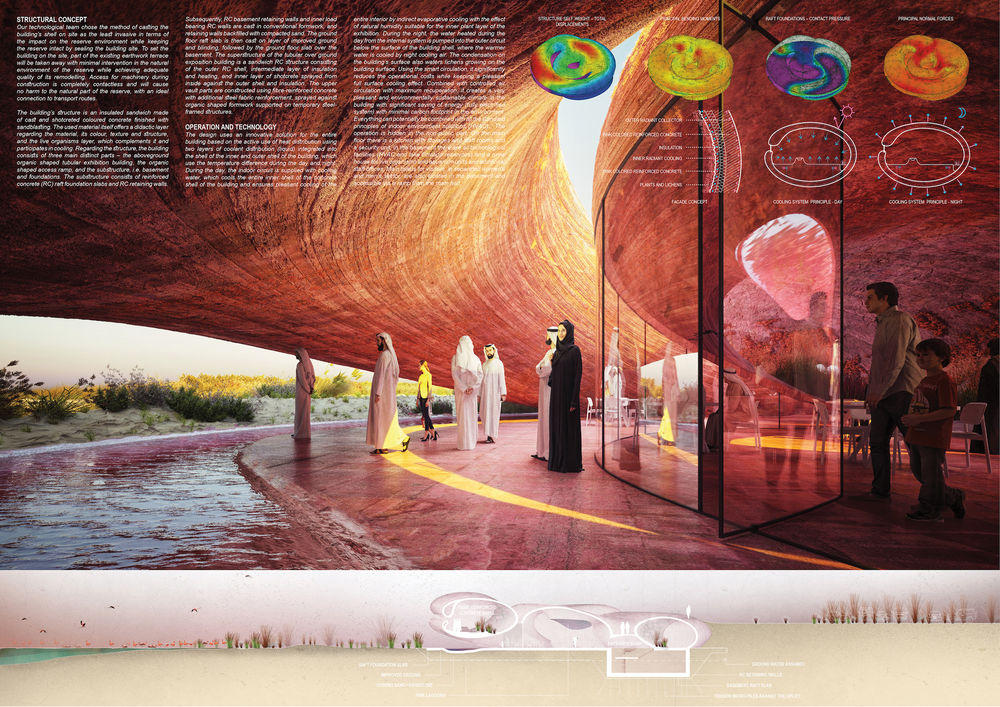
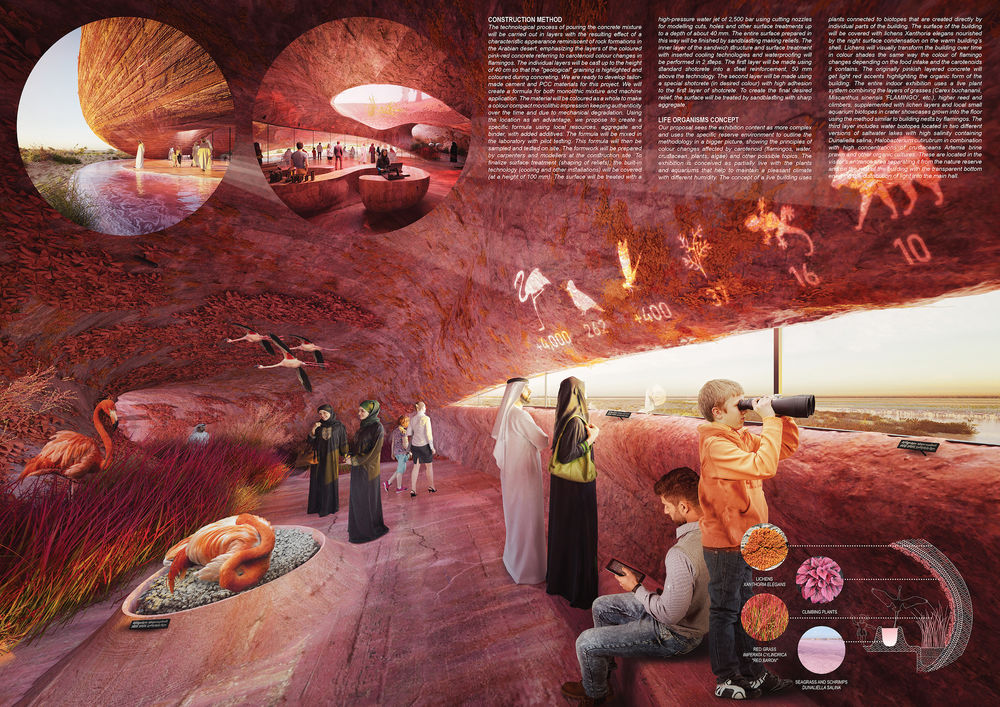
结构概念和施工方法 Description of preliminary structural concept and construction method
该建筑的结构是一个隔热夹层,由经过喷砂处理的浇铸和喷火彩色混凝土制成。其所使用的材料本身就形成了一种特殊的颜色、纹理和结构的指导层,以及可作为补充并参与冷却的微生物层。
其中,浇筑混凝土混合物的工艺过程将分层进行,由此形成的独特外观,会使人联想到阿拉伯沙漠的岩层,而强调粉红色的混凝土分层,则仿佛火烈鸟中类胡萝卜素的颜色变化。建筑各层将浇铸到 40 厘米的高度,从而突出当地的“地质”纹理。我们在混凝土浇筑过程中,对每一层都会进行着色处理。
The building’s structure is an insulated sandwich made of cast and torcreted coloured concrete finished with sandblasting. The used material itself offers a didactic layer regarding the material, its colour, texture and structure, and the live organisms layer, which complements it and participates in cooling.
The technological process of pouring the concrete mixture will be carried out in layers with the resulting effect of a characteristic appearance reminiscent of rock formations in the Arabian desert, emphasizing the layers of the coloured pink-red concrete referring to carotenoid colour changes in flamingos. The individual layers will be cast up to the height of 40 cm so that the “geological” graining is highlighted. The individual layers will be coloured during concreting.
▼建筑各层结构示意图 Floor structural concept
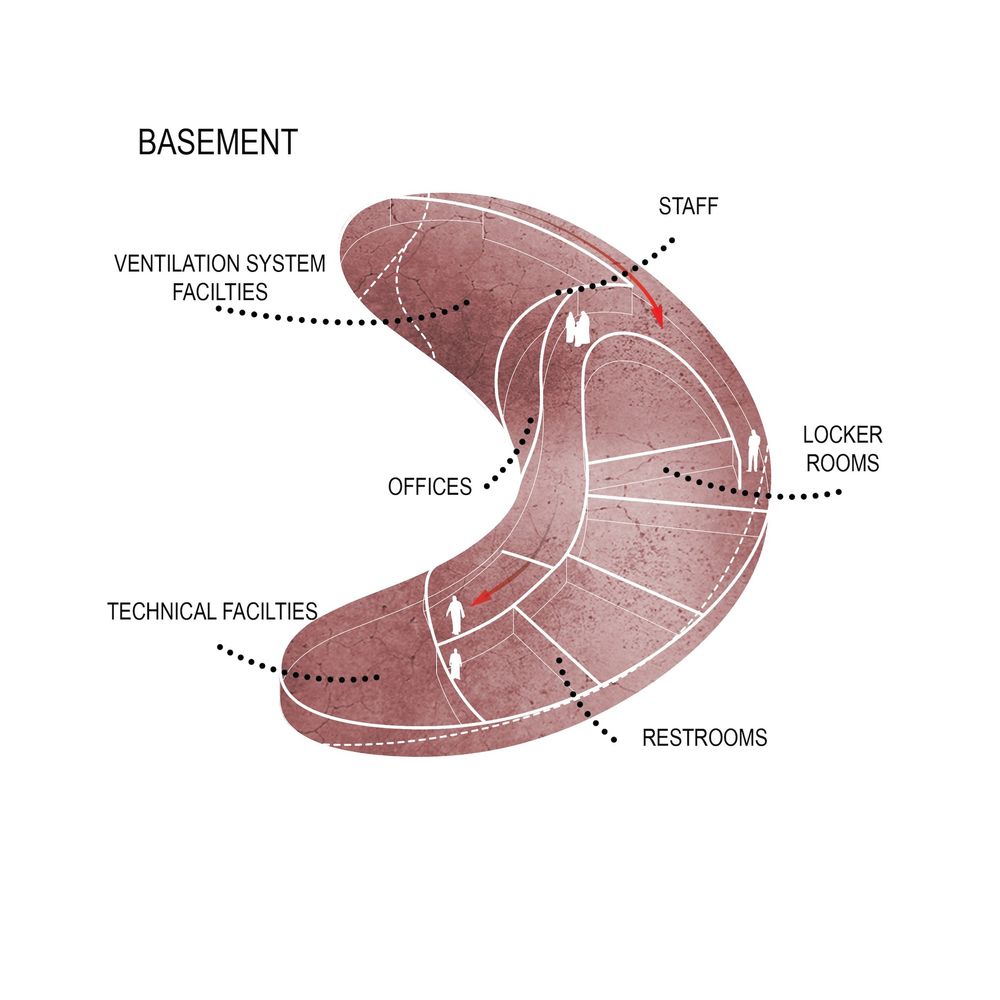
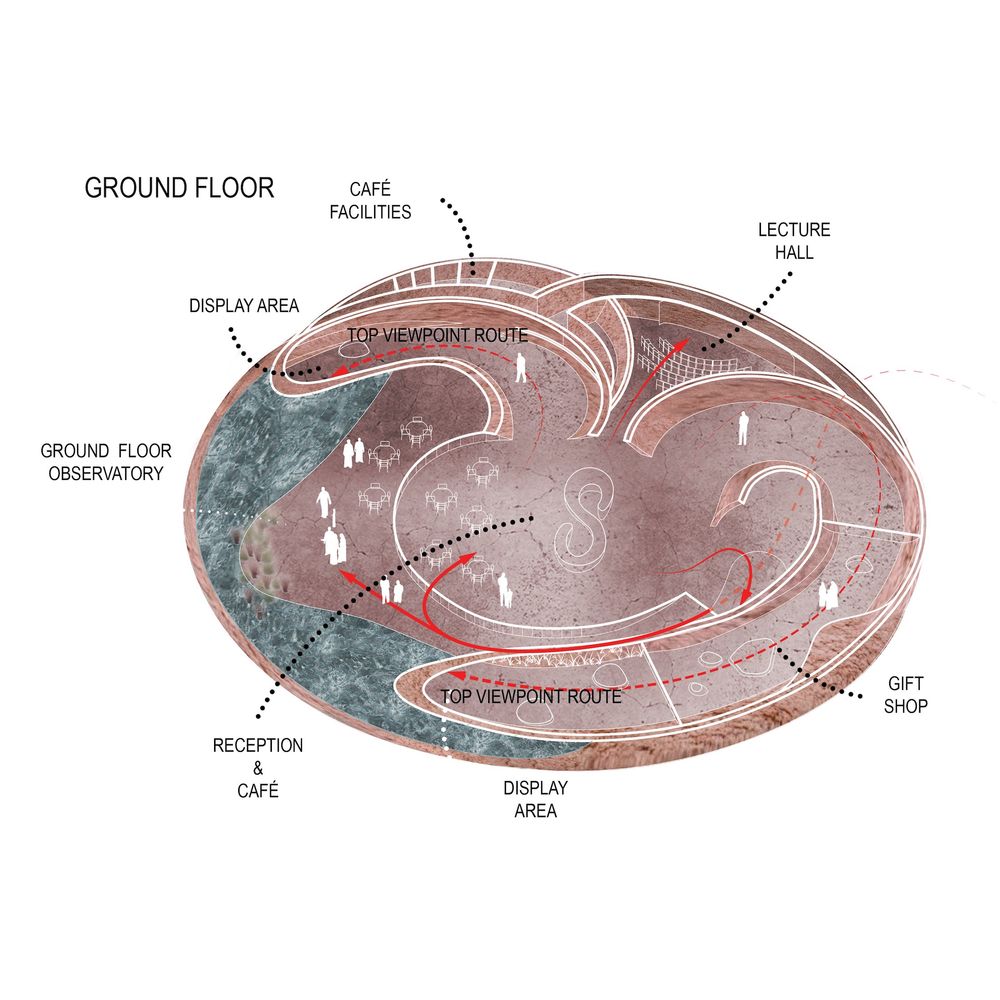

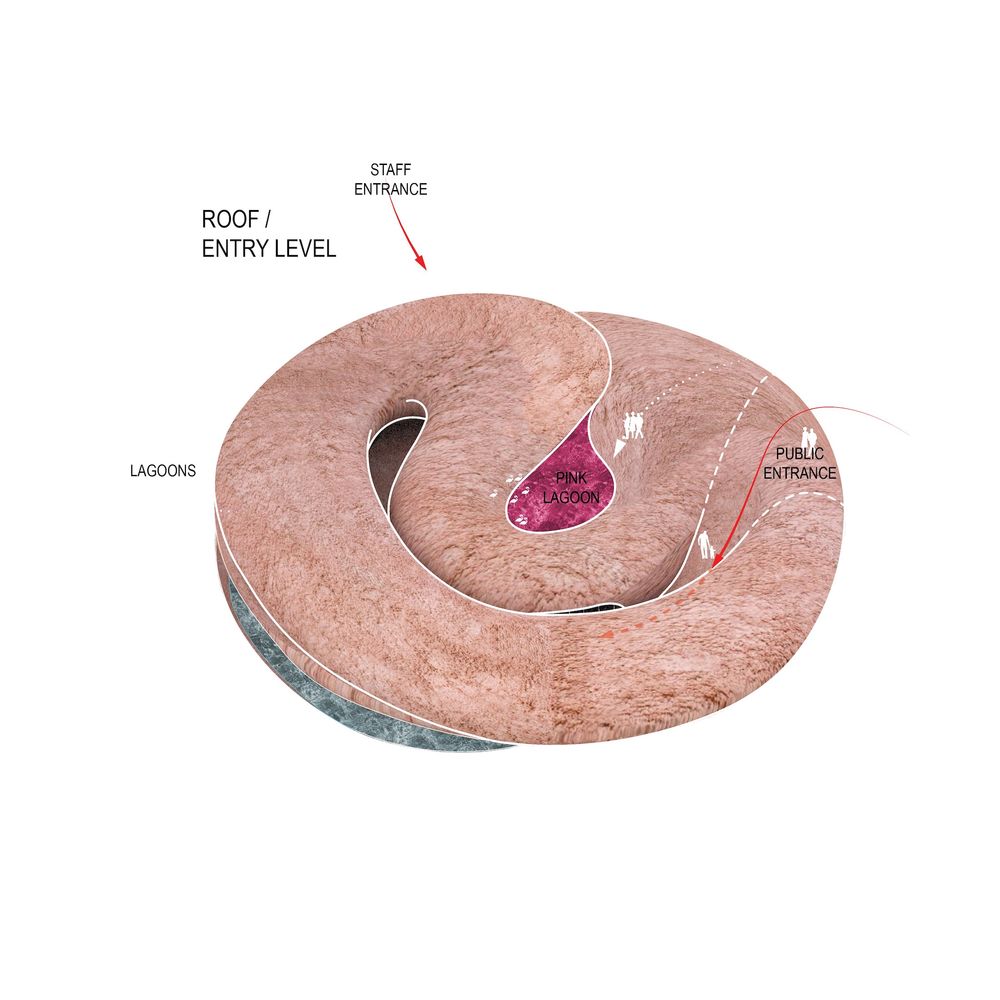
建筑技术 Technology
整个建筑设计采用了一种创新型的解决方案,包括积极利用热量分布,利用两层冷却剂 (液体) 分别集成到建筑的内外壳中,以及利用昼夜温差。白天,通过室内回路供应冷却水,冷却的整个内壳层建筑的混凝土外壳,确保整个室内通过间接蒸发冷却达到自然湿度,保证内部植物层的展览需求。在夜间,白天从内部系统中加热的水被泵入建筑外壳表面以下的外部回路,在这里,较温暖的水会被夜间的冷空气降温冷却。建筑表面的凝结水也可用于浇灌生长在建筑表面的地衣。另外,建筑中使用的智能循环,不仅达到了非常好的全表面冷却效果,还能大大降低运行的成本。结合可控制的空气循环和最大限度的回收,它在建筑中创造了一个非常宜人和环境可持续的气候,显著节约了能源 (全电气化系统) 并达到了最小的碳排放。
The design uses an innovative solution for the entire building based on the active use of heat distribution using two layers of coolant distribution (liquid) integrated into the shell of the inner and outer shell of the building, which use the temperature difference during the day and night. During the day, the indoor circuit is supplied with cooling water, which cools the entire inner shell of the concrete shell of the building and ensures pleasant cooling of the entire interior by indirect evaporative cooling with the effect of natural humidity suitable for the inner plant layer of the exhibition. During the night, the water heated during the day from the internal system is pumped into the outer circuit below the surface of the building shell, where the warmer water is cooled by night cooling air. The condensation on the building’s surface also waters lichens growing on the building surface. Using the smart circulation, it significantly reduces the operational costs while keeping a pleasant full surface cooling effect. Combined with controlled air circulation with maximum recuperation, it creates a very pleasant and environmentally sustainable climate in the building with significant saving of energy (fully electrified system) with minimal carbon footprint in the environment.
▼建筑冷却系统 Cooling system
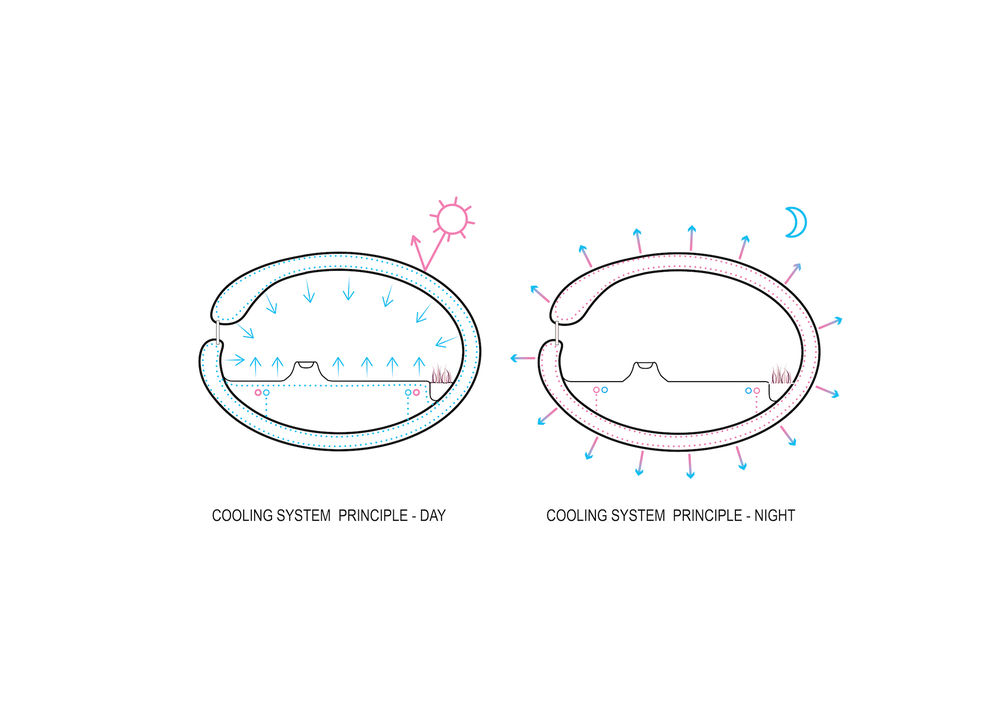

▼建筑剖面图Section

生命有机体概念 Life organisms concept
建筑有机概念通过使用植物连接到生物群落,而这些生物群落由建筑的各个部分直接创建。建筑表面覆盖着苔藓,这些苔藓是由夜晚在温暖的建筑外壳上的凝结水浇灌而成。就像火烈鸟的颜色会随着食物摄入量和所含类胡萝卜素的变化一样,苔藓会随着时间的推移在视觉上改变建筑的颜色。原本粉红色的分层混凝土将变成浅红色,突出建筑的有机形式。整个室内展览也采用了活的植物系统,并结合了草本植物层 (布坎南苔草、火烈鸟芒草等)、芦苇和攀缘植物,辅以地衣层和当地水族小生物,这些生物生长在弹坑陈列室的地板上,类似于火烈鸟的筑巢。第三层包括位于两个不同版本的咸水湖中的水生物群,这两个不同版本的咸水湖含有高盐度的杜氏盐藻、红色盐生细菌以及高浓度的甲壳类动物卤虫、盐水虾和其他有机培养物。一个位于游客入口区,将游客与自然保护区隔开,一个位于建筑物的屋顶上,透明的底部确保光线可照入主厅。
The concept of a live building uses plants connected to biotopes that are created directly by individual parts of the building. The surface of the building will be covered with lichens Xanthoria elegans nourished by the night surface condensation on the warm building’s shell. Lichens will visually transform the building over time in colour shades the same way the colour of flamingo changes depending on the food intake and the carotenoids it contains. The originally pinkish layered concrete will get light red accents highlighting the organic form of the building.
The entire indoor exhibition uses a live plant system combining the layers of grasses (Carex buchananii, Miscanthus sinensis ‘FLAMINGO’, etc.), higher reed and climbers, supplemented with lichen layers and local small aquarium biotopes in crater showcases grown into the floor using the method similar to building nests by flamingos. The third layer includes water biotopes located in two different versions of saltwater lakes with high salinity containing Dunaliella salina, Halobacterium cutirubrum in combination with high concentrations of crustaceans Artemia brine prawn and other organic cultures. These are located in the visitor’s entrance area separating it from the nature reserve and on the roof of the building with the transparent bottom ensuring the distribution of light into the main hall.
▼建筑有机立面设计 Life organisms concept


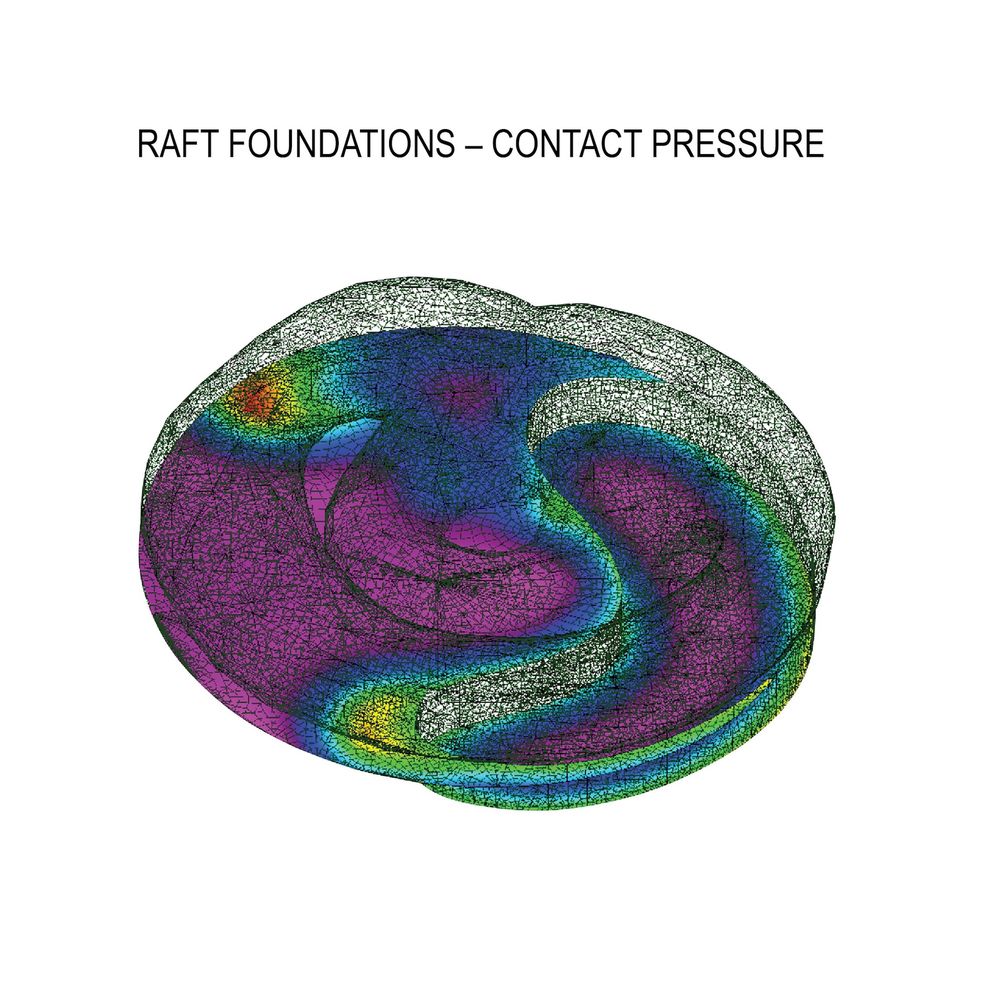

▼场地平面图 Site Plan
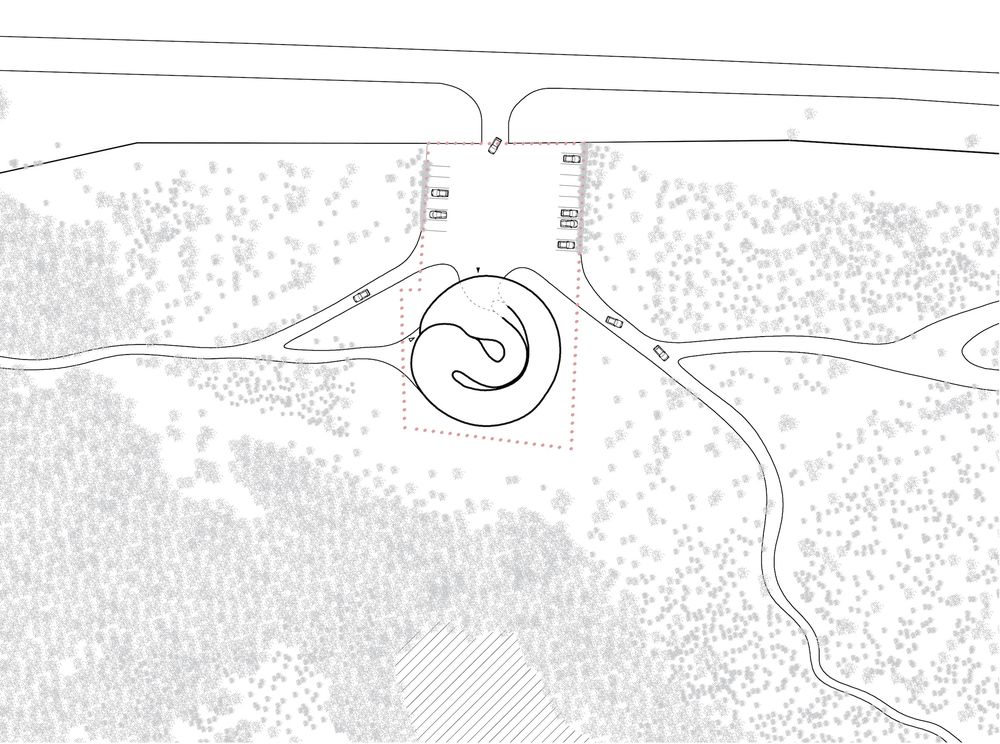
▼建筑各层平面图 Floor Plans

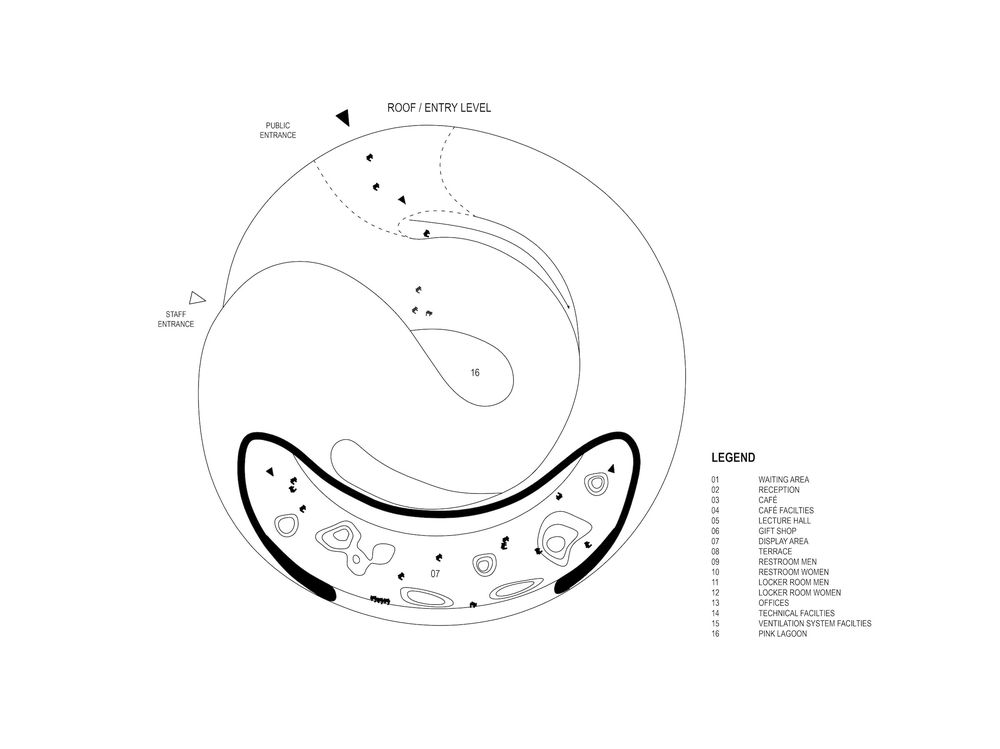
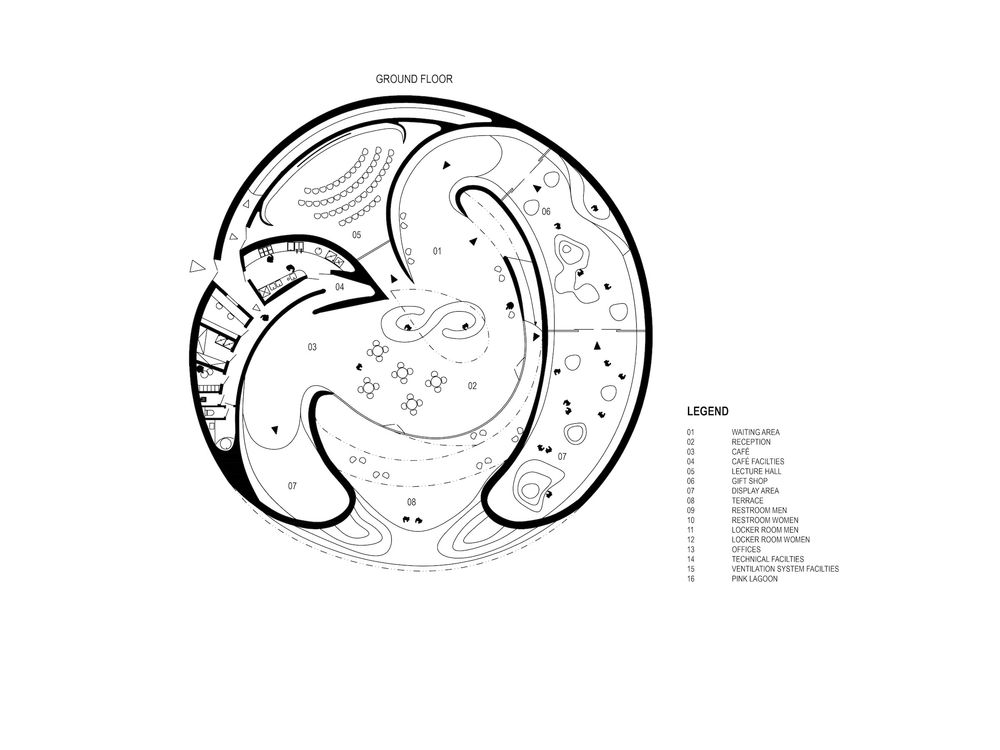
工作室:petrjanda/brainwork
设计师:Petr Janda
团队成员:Anna Podroužková, Kateřina Tšponová, Tomáš Pevný
项目地点:阿布扎比 Al Wathba 湿地保护区
项目:2020 年
客户:阿布扎比环境署 (EAD)
模型:Jiří Šmejkal | Parametr Studio
静力学:Jan Tomšů | Agile Consulting Engineers
空调:František Arnošt | Active Elements
技术:Leo Lappy | AVE Servis
植物:Jitka Tomsová | Atelier Rouge
鸟类学:Libor Veicenbacher
Studio: petrjanda/brainwork
Author: Petr Janda
Team members: Anna Podroužková, Kateřina Tšponová, Tomáš Pevný
Project location: The Al Wathba Wetland Reserve, Abu Dhabi
Project year: 2020
Client: The Abu Dhabi Environment Agency (EAD)Parametric model: Jiří Šmejkal | Parametr Studio
Statics: Jan Tomšů | Agile Consulting Engineers
HVAC: František Arnošt | Active Elements
Technology: Leo Lappy | AVE Servis
Vegetation: Jitka Tomsová | Atelier Rouge
Ornithology: Libor Veicenbacher

